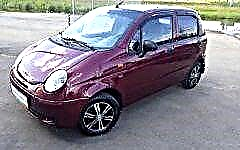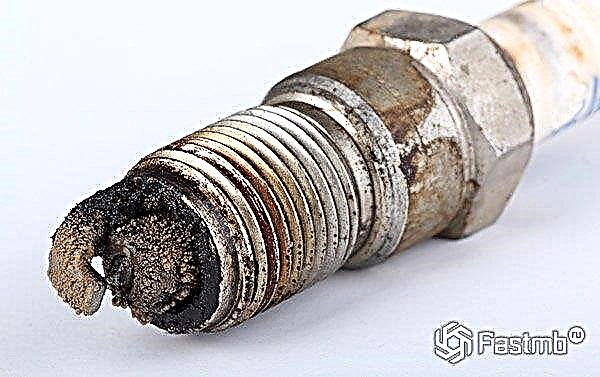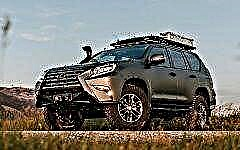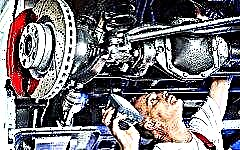

The content of the article:
- Diagnostic options
- What the undercarriage consists of
- The most worn out "consumable" elements of the undercarriage
- Stages of diagnostics of the undercarriage
The chassis of the car is designed to move and control it, as well as to absorb vibration and shock loads on the body when driving on uneven road surfaces. Therefore, running diagnostics is the most important and necessary condition for comfortable and safe vehicle operation.
After all it is the "chassis" that is the main part of the machine design, on which ride comfort and traffic safety directly depend. You can drive a car with many malfunctions (electrical, body, engine), but it is precisely because of malfunctions in the chassis that the car can literally "fall apart in the middle of the road."
Diagnostic options

In general, the diagnostics of the undercarriage of the machine can be divided into three options:
- Emergency (emergency) - when, during the operation of the car, a knock and clanking in the chassis is already clearly audible, an extraneous knock when turning the steering wheel. The car behaves unstable at high speed, gives a strong roll when cornering, "jumps" on holes. At the moment of braking, the car leads to the side, and when it picks up speed, it pulls the steering wheel to the side. That is, the "chassis" is so worn out that the operation of the car becomes uncomfortable and unsafe.
- Planned - when the diagnostics "running" is scheduled for a certain time and is carried out regardless of the state of the car. For example, an off-season diagnostic examination, before the beginning of winter or summer.
- Pre-purchase - diagnostics of the running gear of a used car before buying it.
Any variant of the running gear diagnostics assumes the same set of actions, most of which can be performed independently, without the involvement of a specialist. But, of course, before making an independent diagnosis, you need to know what, where and how to examine.
Also, it will not be superfluous to carry out a complete diagnosis of the car using a personal scanner. For example, this can be done with an inexpensive multibrand Rokodil ScanX device.

The device will analyze the data and, if errors are found, will indicate the problem element. With this diagnosis, you can identify defects in the suspension, tires, frame and axle block. The scanner is compatible with most cars since 1996, with an ODB2 connector. Information is displayed on the screen of your phone or tablet with a detailed description of the malfunction.
What the undercarriage consists of

The chassis consists of a set of units, elements and mechanisms, to which torque is transmitted from the engine (through the transmission and drive), as a result of which the car moves along the road. The main elements of the undercarriage are:
- load-bearing body (or frame);
- suspension (front and rear);
- bridge beams;
- wheels (with disks and tires).
Additionally, in the chassis there are many more auxiliary mechanisms and elements: shock absorbers, ball joints, levers, brakes, springs, anthers, silent blocks, etc. And each of these elements and mechanisms performs its own separate functions for moving the car, controlling it, reducing vibrations and vibration loads when driving over bumps. Most of the additional elements are located on the suspensions.
The most worn out "consumable" elements of the undercarriage

The following elements of the undercarriage, which are also called "consumable", are subject to the greatest and fastest wear:
- Ball joints - articulated mountings, with which the suspension arm is attached to the wheel hub.
- Stabilizer rack - a thin rod that has knuckles and connects the ends of the anti-roll bar to the middle part of the suspension.
- Shock absorbers, hydraulic struts and springs - are buffer parts between the wheels and the suspension and serve to cushion the shock load when driving on uneven road surfaces.
- Mounting rubber bushings - located in the bolt connections. They serve to absorb shock and vibration loads and perform hinge functions.
- Silentblocks - rubber-metal hinges for suspension arms.
- Rubber covers (anthers) - resemble an accordion. They serve to protect joints from road dust and corrosion.
- Oil seals - rubber rings to prevent oil leakage in the components.
Also, bearings and hubs are subject to great wear, which significantly affects the car's handling. Therefore, they should also be checked frequently.
Stages of diagnostics of the undercarriage
It is better to divide the diagnostics of the car's undercarriage into two stages:
- When driving.
- In place (static).
Running gear diagnostics while driving

Diagnostics of "running" while driving is quite simple. All that is required from the driver is attentiveness. It is necessary to observe the behavior of the car at speed and when braking, as well as to identify by ear extraneous abnormal sounds (knocking, grinding, creaking, etc.) when driving on a normal good and bad dirt road. For example:
- When driving at high speed, the car becomes unstable. There is also an increase in steering play - problems with the steering rack or with the steering rod mountings.
- When driving on the highway, the car leads to the side - wheel alignment is not adjusted. Different tire pressures. Different tires. Sometimes a deformed body can be the cause.
- When driving, vibration is felt in the steering wheel - the wheels are incorrectly balanced. Worn or pinched wheel bearings. Worn steering joint. Wheel nuts are loose. The wheel rim is deformed.
- When you turn the steering wheel in different directions, at a speed of 20-30 km / h, you can hear clicks or a creak - the hinge of equal angular velocities (CV joint, which is often called a "grenade") is faulty. Also, these sounds may indicate a malfunction of the support bearing.
- When cornering, a strong body roll is felt - the stabilizing system of the chassis is faulty.
- When braking, the car goes to the side, the braking distance increases - the brake pads or drums are badly or unevenly worn out.
- When driving on an uneven (especially unpaved) road, a knock is heard in the area of the wheels, under the wings of the body - the ball joint is worn out, the shock absorber is faulty or its rubber mounting sleeve is worn out. The hydraulic strut may also be faulty ("blow-out" when fluid has flowed out of the strut). Spring breakage is possible. If a knock is heard from the back, it is also likely that the shock absorber, spring, rubber mount sleeve, or C-pillar is defective.
- A dull knock during rapid acceleration - the silent blocks are worn out and have lost their elasticity.
- When driving on a flat road, a hum is heard - the hub bearing is worn out.
- Squeak when braking when cornering - shock absorbers are faulty or stabilizer bushings are worn out.
On-site undercarriage diagnostics (static)

For a more thorough self-diagnosis of "running", you will need an inspection pit (in the garage) or a special overpass (on the street). Also, for the inspection you will need:
- jack (or hydraulic lift);
- regular screwdriver;
- mount (or crowbar - "crowbar");
- Lantern;
- gloves.
If possible, it is better to use the lift, as in a car service. In addition, the presence of an assistant is desirable.And, of course, the bottom of the car and the elements of the chassis should be more or less clean so that when viewed from above, dirt does not fall, and the inspected elements are clearly visible.
- It is better to start the general diagnostics of the chassis with the front suspension.while lifting the bonnet to inspect the upper struts. It is important here that the car is standing and not hanging, as the suspension must be loaded. It is necessary to check the gap between the cup and the body with a screwdriver. If the screwdriver fits freely into the gap, and the size of the gap itself is 1.5 cm or more, then it's time to change the top pillow.
- You can immediately check the support bearing by grasping the rod and shaking the front end in different directions.... If play is felt, it means that the bearing is worn out and is a source of knocking when driving on uneven roads. Particularly good knocking is heard when driving through a speed bump.
- At the same time, here you need to check the performance of the shock absorbers and hydraulic struts. A sign of their malfunction will be the buildup of the car. To detect the buildup, press on the wing from above with your hands and release it sharply. If the front end smoothly returned to its original position, then there are no problems with the shock absorber or the strut. If the front end made more than two rolls and jumped like a ball, then there is a problem with the shock absorber or hydraulic strut.
Such a simple procedure is often done even by not very experienced car enthusiasts when buying a used car. If you suspect a shock absorber or hydraulic strut malfunction, a more thorough inspection of these parts will be required by lifting the machine with a jack or a lift.
Visually, the malfunction of the strut or shock absorber is determined by the leakage of fluid from them. Also, visually (or through the buildup), you can determine the wear of the rubber mounting sleeve of the shock absorber, due to which knocking can also occur. - Now you need to raise the car with a jack (or a hydraulic lift, or on a car service lift) and shake the front wheels "to a break". In this way, you can detect the knock of the steering rod, its tip or the ball joint. For a more accurate determination of where the knocks and there is a backlash, an assistant may be required. While one will wobble the wheel, the second will be able to determine the exact location of the malfunction by touch.
Also, the critical wear of the ball joint can be determined by swinging the lever by hands near the support itself. If there is not enough strength to determine the backlash, then you can use a pry bar (or a crowbar). To do this, the pry bar must be inserted between the fist and the lever, and then wiggled. If the ball joint is in good condition, there should be no backlash and knocking.
- Simple spinning of the wheel will determine the wear of the hub bearing. If there is a hum or grinding noise during the rotation of the wheel, the bearing must be urgently replaced.
- Rear suspension diagnostics should start with the wheels., just like the front. The ball joints and tie rods at the rear do not need to be checked, because they are not there. Wheel bearings are also checked by rolling and swinging the wheel "for break". If there is no hum during rotation and backlash during wobble, then the wheel bearing can be considered serviceable.
Next, you should check the shock absorbers and struts for fluid leakage. Inspect the springs. Visually, the subsidence of the springs is not always noticeable, but their breakage is not difficult to notice.
- At the last stage (or in the process) all rubber elements are inspected: silent blocks, anthers (covers), mounting bushings. The silent blocks should not be cracked or damaged. Also, they should not give excessive play and be easily squeezed when the lever is displaced with a pry bar.
Anthers (in the form of an accordion) should also not have cracks and damage. A cracked but not yet torn boot can still be used for a while, but it is best to replace it as soon as possible. Sometimes the anthers lose their elasticity, as a result of which grease begins to seep from under them. Such anthers (as well as torn ones) must be replaced immediately.
The mounting bushings not only absorb shock loads, but also act as hinges for the mobility of the suspension elements. Accordingly, they are susceptible to destruction and erasure. If the protruding edges of the rubber bushing (on the rod, suspension arm, or shock absorber eye) are cracked, then the bushing must be replaced. Also, the bushing must be replaced if the pin has shifted from the center of the lug to the edge.
Conclusion
Self-diagnosis of the car's running gear is undoubtedly useful and helps to save a lot of money. After all, there are many car owners who are able to fix problems in the chassis on their own.
However, it should be remembered that a full-fledged "running" diagnostics is possible only if there is appropriate knowledge of the vehicle design and using professional bench-diagnostic equipment in a specialized service station.











